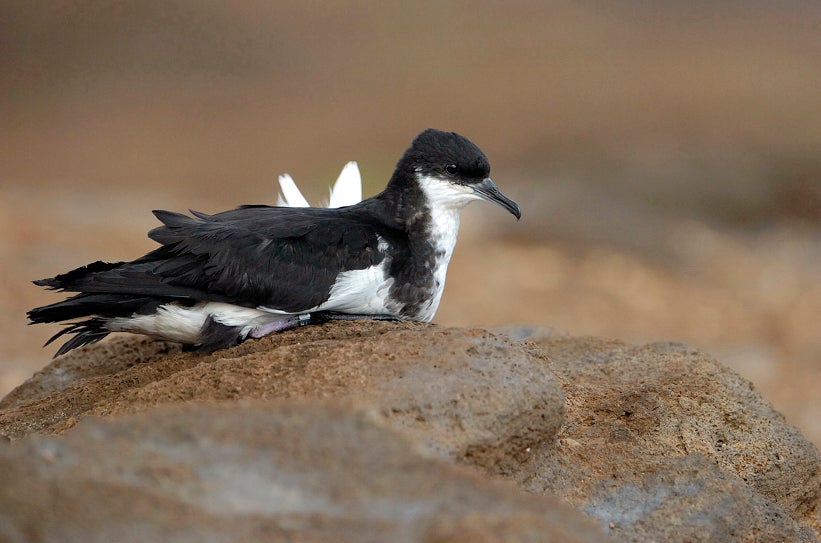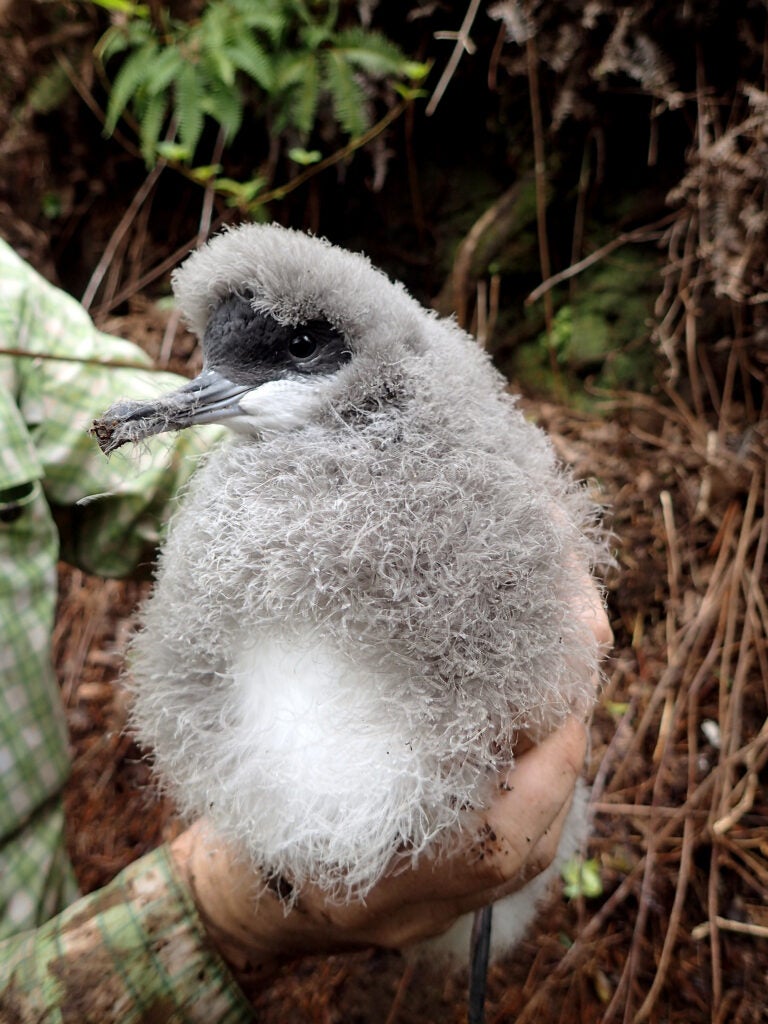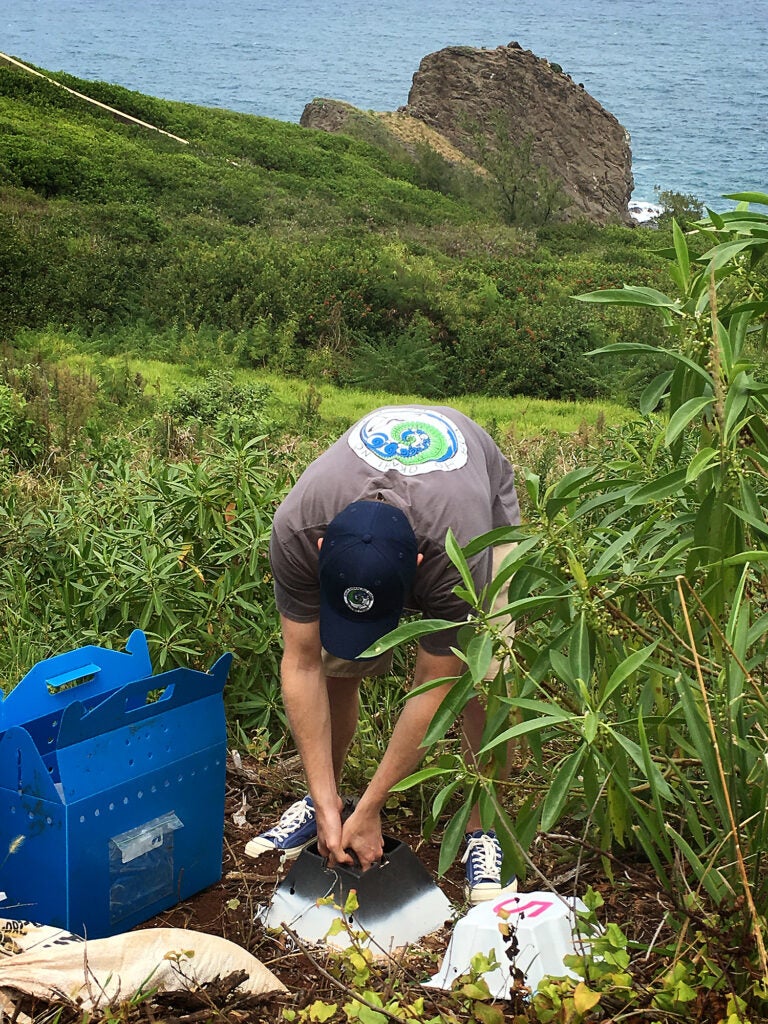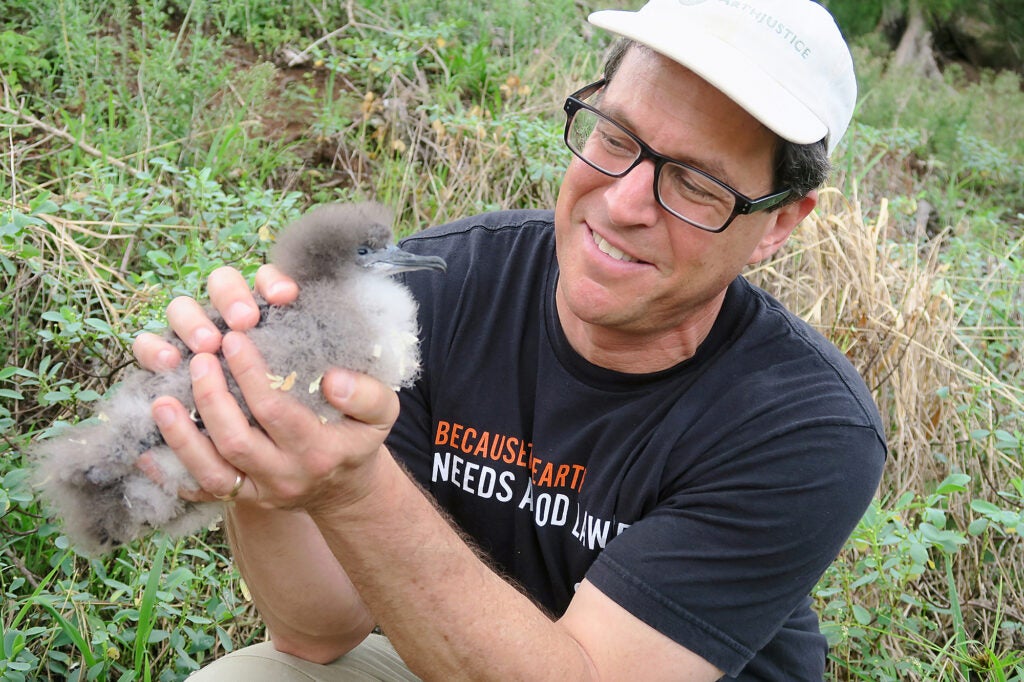One Small Seabird Egg Offers Hope for Hawai‘i’s Biodiversity
The endemic Newell’s shearwater has a chance at survival thanks to an innovative team of conservationists, researchers, and Earthjustice lawyers.

This page was published a year ago. Find the latest on Earthjustice’s work.
This past summer, a fist-sized ball of gray-and-white fluff burst out of its shell and, several months later, took flight into the salty sea sprays and cool winds of the Pacific ocean.
The arrival of the Newell’s shearwater chick within the Nihoku Ecosystem Restoration Project on Kaua‘i, the first-ever to both hatch and fledge there, signals extraordinary potential far outweighing its tiny, two-ounce body.
Though they once filled Hawai‘i’s skies with their unique braying birdsong, the Newell’s shearwaters’ population has nosedived over the past few decades.
Nihoku’s groundbreaking milestone is the result of a multi-faceted effort launched several years ago among scientists and bird enthusiasts — and funded in part by the successful litigation of Earthjustice lawyers. The project serves as living proof that years of innovative science, commonsense measures, and smart litigation can help restore imperiled species and repair ecosystems — even amid a worsening biodiversity crisis.
As species loss accelerates, it’s critical that we defend the legal tool that made the shearwaters’ recovery possible — the Endangered Species Act (ESA). Under the last Trump administration, Earthjustice went to court to defend this bedrock law from efforts to gut it. Over the past few years, many provisions of the law were fully restored. As the new Trump administration prepares to take office, we’re ready to fight relentlessly for the ESA again.

A Newell’s shearwater (ʻaʻo) chick carefully removed from a burrow to be moved to the protected Nihoku area of the Kilauea Point National Wildlife Refuge on Kaua‘i. (Andre Raine / Kauaʻi Endangered Seabird Recovery Project)
Harbingers of Biodiversity Loss
Newell’s shearwaters spend most of their lives at sea, flying thousands of miles and diving more than 100 feet deep into the ocean in search of small fish and squid. Once ready to breed, at about five or six years, they make their nocturnal return to their original nesting sites hidden deep within the mountains. Like ancient seafarers, shearwaters are guided by the moon, the stars, and generational memory.
Shearwaters are deeply interconnected with the Hawaiian landscape and ecosystem — for example, studies have suggested their guano enhances the growth rates of coral reefs, which both serve as essential habitat for marine life and protect coastlines from storms and erosion.
Newell’s shearwaters have also played a significant role in the culture of Native Hawaiians, who named the species ʻaʻo because of its distinctive call. Early Polynesian explorers relied on seabirds like Newell’s shearwaters for centuries to find their way back to land after fishing or trading voyages. Today, Hawaiian fishermen continue to rely on the birds to lead them to schools of fish.
Between 1993 and 2013, Newell’s shearwater numbers have plummeted by 94% on Kauaʻi, where the majority of the population remains today. Invasive predators like cats, rats, and pigs are a major threat. But so, too, are artificial lights and power lines. The former mimic natural light and can confuse the birds to exhaustion, while collisions with the latter can break a bird’s bones or tear off its feathers and skin, sometimes killing them.
The shearwaters’ decline is part of a larger trend: Well over half of Hawaiʻi’s 113 endemic bird species and subspecies have gone extinct or are presumed extinct since humans first arrived. And today, Hawai‘i is known as the “bird extinction capital of the world.” Worldwide, scientists predict that nearly 40% of all animal and plant species face extinction by the end of this century, a hollowing out of biodiversity that could upend irreplaceable ecosystems and disrupt human civilization.
For more than three decades, Earthjustice’s Mid-Pacific office has been involved in advocacy and litigation efforts to protect Hawai‘i’s imperiled seabirds. In the early 90s, after attorneys learned of a utility company’s plan to string power lines in a valley on the North Shore of Kauaʻi, Earthjustice sued the utility for its reckless proposal, which was sited smack in the middle of an important flyway for birds. At the time, both Newell’s shearwaters and Hawaiian petrels, another endemic seabird whose call gave it its Hawaiian name, ʻua‘u, were already gravely imperiled and listed under the Endangered Species Act.
“Facing the decline of entire species in Hawai‘i is deeply unsettling,” says Earthjustice attorney David Henkin, who helps lead the imperiled seabird litigation. “Who wants to imagine Hawaiʻi without the distinctive calls of the ‘a‘o and ʻua‘u ?”
The Earthjustice lawsuit eventually blocked the North Shore power line proposal, and it forced the utility to fund a study on power line interactions with birds that would become useful in future advocacy. Yet the utility, later taken over by the Kauaʻi Island Utility Cooperative, refused to implement commonsense measures for existing power lines like undergrounding, rerouting, and reconfiguring them to reduce seabird deaths.
Over the next several years, Earthjustice expanded its efforts to protect Kauaʻi’s seabirds by suing the utility for the injury and death its power lines and streetlights inflict on shearwaters and petrels island-wide, as highlighted in the utility’s own study. In addition, Earthjustice sued the St. Regis Princeville Resort, a luxury hotel that was, at the time, responsible for the greatest number of deaths and injuries to imperiled seabirds caused by artificial lights on Kauaʻi. These lawsuits, among other endeavors, ultimately helped pool together several million dollars in conservation efforts for Hawaiʻi’s only two endemic seabirds.

A Newell’s shearwater (ʻaʻo) chick was placed in its new home in the protected Nihoku area of the Kilauea Point National Wildlife Refuge on Kaua‘i. (Jen Waipa / USFWS)
A New Era in Seabird Conservation
Shearwaters and petrels aren’t easy animals for humans to protect. Both spend most of their time at sea, and, when they do return to land to breed, they’re determined to return to their original nests, even if those nests become vulnerable to predators or development. Both birds also have low reproductive rates.
Conservationists knew that to safeguard the imperiled birds they needed to put their eggs in multiple, well-guarded baskets. Together, groups like Pacific Rim Conservation and American Bird Conservancy came up with a plan. They decided to implement protections for natural breeding colonies in northern Kauaʻi, while also translocating chicks from existing colonies to establish a new seabird colony at the Kīlauea Point National Wildlife Refuge on Kauaʻi’s North Shore. The latter effort, known as the Nihoku Ecosystem Restoration Project, would be the first (and so far only) fully protected colony of federally listed seabirds anywhere in the Hawaiian Islands.
“[Nihoku] was the start of a new era in seabird conservation,” says Lindsay Young, former Executive Director of Pacific Rim Conservation. “We created a new home for a species that desperately needs it.”
Over the years, the conservationists utilized funds from multiple sources, including those obtained through Earthjustice litigation, to create safe spaces for translocated birds by eradicating predators and invasive plant species from the protected areas. They also installed the centerpiece of the Nihoku project, a predator-proof fence around an eight-acre area inside the refuge.
“This is kind of an all-or-nothing thing,” says Brad Keitt, Oceans and Islands Director at American Bird Conservancy, who adds that the money stemming from Earthjustice’s litigation helped fill the funding gaps for building the fence. “The settlement funds were key in making sure we hit 100% of our objectives. If you don’t finish the fence, that 100% turns to zero because you’ve got invasive species killing your translocated birds.”
Since translocation began in 2015, 192 Newell’s shearwaters and Hawaiian petrels have fledged at Nihoku — for a success rate of over 97%.

Earthjustice attorney David Henkin holds a Newell’s shearwater chick. (Earthjustice)
Moving the Fight to Maui
Following success on Kaua‘i, Earthjustice’s fight to protect Hawaiʻi’s endemic seabirds has expanded to Maui and beyond. In November, Earthjustice reached a settlement with Hawai‘i’s largest electric utility over the harm that power lines in Maui County cause imperiled Hawaiian seabirds. Under the settlement, the company has agreed to develop a habitat conservation plan to address the harm its power lines cause and to fund seabird habitat protection projects on Maui to the tune of nearly $500K per year. Earthjustice also recently filed another lawsuit to reduce the ongoing threats posed by county streetlights to endangered and threatened seabirds on the islands of Maui and Lāna‘i.
In addition to upholding the law, these legal suits and the conservation projects they help facilitate are leading to better understanding of how best to protect birds from human actions, as well as restore the ecosystems on which we all depend.
In 2022, for example, the Kīlauea Point Refuge, one of the most popular visitor attractions on Kauaʻi and home to Nihoku, expanded its efforts to protect the entire peninsula from invasive species predation by replacing its perimeter fence with a state-of-the-art version made with stainless steel. The new fence, which was modeled off the smaller fence at Nihoku, serves as a “giant educational outreach project about how humans can actively protect imperiled species,” says Keitt of American Bird Conservancy.
As both the climate and biodiversity crises worsen, getting that message of hope out to the public is critical to making these projects happen on a broader scale.
“These types of projects won’t happen without the support of the people.”
Established in 1988, Earthjustice's Mid-Pacific Office, located in Honolulu, Hawaiʻi, works on a broad range of environmental and community health issues, including to ensure water is a public trust and to achieve a cleaner energy future.